 The Gendron Tarot: This deck is my personal favorite, and easily my most used deck. You can see for
yourself the beauty the art work reaches. The Gendron is primarily a Waite Child deck, but the Artist has taken some creative liberties, that I for one appreciate. First off the Traditional Court has been reorganized into a more female friendly vision. Queen King Princess Prince, are the characters in the Court in this deck. I find the balance of Male and Female Characters, and therefore energies, appealing. The Artist also made a real effort to create a Multi-Cultural deck. The images I think capture more of the
human experience for this effort. Tied into Melanie's Multi-Cultural approach is her use of Totems as symbols. Although this takes a little adjustment, they are well explained in the LWB, and work well and add a lot visually to the deck.
The Gendron Tarot: This deck is my personal favorite, and easily my most used deck. You can see for
yourself the beauty the art work reaches. The Gendron is primarily a Waite Child deck, but the Artist has taken some creative liberties, that I for one appreciate. First off the Traditional Court has been reorganized into a more female friendly vision. Queen King Princess Prince, are the characters in the Court in this deck. I find the balance of Male and Female Characters, and therefore energies, appealing. The Artist also made a real effort to create a Multi-Cultural deck. The images I think capture more of the
human experience for this effort. Tied into Melanie's Multi-Cultural approach is her use of Totems as symbols. Although this takes a little adjustment, they are well explained in the LWB, and work well and add a lot visually to the deck.
The Gendron however attracts strong opinions good and bad. If you read the reviews at Amazon you will see what I mean. Melanie's trump cards are executed to a universally high level. They can be a challenge though as she is quite willing to depart from the expected imagery. The High Priestess, is depicted as a crystal, with human limbs, and face. This is not meant disrespectfully. Melanie proudly states time and again that she spent 5 years on her deck. Working and in Meditation on the images. She wants to challenge our preconceptions of the Tarot, and she does, that will always provoke some discomfort. The other issue that comes up when considering the deck is the minors. The Wands and Cups are done in a sort of near monochrome. Violet for the Cups, a Sort of red tinted brown for the Wands. That combined with the reuse of some images through out the deck has turned off some reviewers. While I see certain recurring characters as guides, connecting various cards. Other reviewers do not agree with me. The minors are not however as beautifully rendered as the trumps, saving the Swords. I think the swords are amazing works of art.
So who should try the Gendron Tarot. I think if the traditional Waite/Thoth decks feel to patriarchal to you, you will like this deck. I think if you are familiar with the Waite Deck, and would like to engage in some comparative tarot, the Gendron by challenging your assumptions will help you grow as a reader. Lastly I think if you are a collector, or more interested in the Tarot for Meditation, and want a deck with beautiful and challenging art. I think you will like this deck.
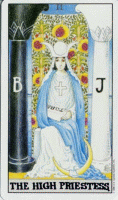 Although Tarot goes back hundreds of years, one of the most significant moments in its history happened less than 100 years ago. When in 1909 Pamela Colman Smith, took a commission from Arthur Waite to create a illustrated Tarot deck under his direction. The Rider Waite Smith deck presented the minors as pictures, and as far as I know, for the first time. This made the Tarot accessible to many many more people. I'm speaking directly from experience here because I found memorizing a pips deck simply impossible. It also was a boon to intuitive readers, because we could now tease meaning out of elements of the pictures that simply where impossible with the pips decks. For all that, the deck simply has a rather disappointing color scheme and its not all that popular today. When Mary Hanson Roberts, recolored the RWS deck to create the Universal Waite deck, new wine truely was poured into an old bottle. The recolored Universal Waite has a spark of life where the RWS deck very often feels flat. I don't think its going to far to say its the difference between watching a black and white, vs color tv. At the same time, with the images of the RWS deck intact, so is the symbolism. Waite was an advanced student of esoteric subjects, and the deck is laced with symbolism for the student to explore and integrate into their readings. The deck certainly has grown on me in the last two years. The better I know it, the more I appreciate this deck.
Although Tarot goes back hundreds of years, one of the most significant moments in its history happened less than 100 years ago. When in 1909 Pamela Colman Smith, took a commission from Arthur Waite to create a illustrated Tarot deck under his direction. The Rider Waite Smith deck presented the minors as pictures, and as far as I know, for the first time. This made the Tarot accessible to many many more people. I'm speaking directly from experience here because I found memorizing a pips deck simply impossible. It also was a boon to intuitive readers, because we could now tease meaning out of elements of the pictures that simply where impossible with the pips decks. For all that, the deck simply has a rather disappointing color scheme and its not all that popular today. When Mary Hanson Roberts, recolored the RWS deck to create the Universal Waite deck, new wine truely was poured into an old bottle. The recolored Universal Waite has a spark of life where the RWS deck very often feels flat. I don't think its going to far to say its the difference between watching a black and white, vs color tv. At the same time, with the images of the RWS deck intact, so is the symbolism. Waite was an advanced student of esoteric subjects, and the deck is laced with symbolism for the student to explore and integrate into their readings. The deck certainly has grown on me in the last two years. The better I know it, the more I appreciate this deck.
I really think this is the best first deck for anyone starting out, most of the texts you find will reference the RWS deck. This will present no trouble to the reader with a Universal Waite. At the same time, its a reader friendly deck, the pictures lend themselves to intuitive reading from the beginning, while the symbolism is there to be explored by students who wish expand their vision of the Tarot.
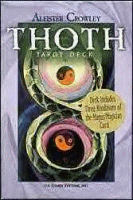 There are two major branches on the Tarot Tree, One is the Waite Deck and its Children, and the other is the Thoth. I may be wrong, but it is my understanding Crowley found the Waite Deck disappointing and childish. So Crowley enlisted the help of Lady Frieda Harris to bring his vision to life on Canvas. She worked very hard, and reworked individual paintings as many as eight times. The result was a Tarot stamped with a enormous depth of symbolism.
There are two major branches on the Tarot Tree, One is the Waite Deck and its Children, and the other is the Thoth. I may be wrong, but it is my understanding Crowley found the Waite Deck disappointing and childish. So Crowley enlisted the help of Lady Frieda Harris to bring his vision to life on Canvas. She worked very hard, and reworked individual paintings as many as eight times. The result was a Tarot stamped with a enormous depth of symbolism.
Friends who use it, champion its no nonsense voice. Now that may sound strange if you have not read Tarot. So let me explain just as a writer has voice so too does a Tarot. You have learned to expect the rhythm of my words and how I express myself, or Stephen King expresses himself. A Tarot has a voice, as a reader you will tune into that voice. I expect you will very like the Thoth if you are looking for a deck with a decidedly Masculine voice. The Thoth is an influential deck with many passionate supporters, its definitely a deck a slightly more advanced reader should consider. The reading of the actual cards is not actually all that different from the Waite, so it does not take a massive relearning process to cross over from one to the other.
On the other hand, and this is strictly my personal view. I simply find the Art Work Repulsive. As a person who used to draw as a hobby, I was rather tied to the view that there is enough ugliness in the world and I was not interested in manufacturing more. A view I do not share with Mr Crowley. Of course the Tarot deals with the sum of human experience, and cannot portray that experience if its all fluff and bunnies. I have not found however a single other deck that comes close to the Thoth in sheer ugliness, but I have spared myself contemplating the Gieger.
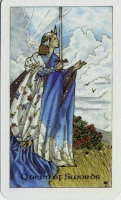 The Robin Wood is a very popular deck and rightly so, it is a fully realized Tarot. The drawing has a very high level of technical skill, a quality I appreciate. Personally I think it outshines both the Waite and the Thoth in this area. At the same time it is a rather pretty deck with a decidedly feminine voice. One should be careful however not to overlook the depth of the symbolism. I did. The All Things Tarot group, formerly had a regular poster who had the online handle of Golanv. (Im told this means raven.) Golanv treated us to series of essays contemplating the symbolism hidden in the Robin Wood. Take the Queen of Swords, The Mail of her helm, speaks to a guarded figure. While her extended right hand is open to accept intuitive knowledge. Her veil, her cloak, the flowers at her feet, and the clouds all have symbolic significance. My point is this is not a deck someone just sat down and drew up. Every aspect of the drawing, the details, the color, the juxtaposition, has been considered and executed.
All these details are explained in Robins book on the deck. Ultimately Robin has gifted us readers with a deck as rich in symbolic meaning as any you could hope to study, and its a joy to behold.
The Robin Wood is a very popular deck and rightly so, it is a fully realized Tarot. The drawing has a very high level of technical skill, a quality I appreciate. Personally I think it outshines both the Waite and the Thoth in this area. At the same time it is a rather pretty deck with a decidedly feminine voice. One should be careful however not to overlook the depth of the symbolism. I did. The All Things Tarot group, formerly had a regular poster who had the online handle of Golanv. (Im told this means raven.) Golanv treated us to series of essays contemplating the symbolism hidden in the Robin Wood. Take the Queen of Swords, The Mail of her helm, speaks to a guarded figure. While her extended right hand is open to accept intuitive knowledge. Her veil, her cloak, the flowers at her feet, and the clouds all have symbolic significance. My point is this is not a deck someone just sat down and drew up. Every aspect of the drawing, the details, the color, the juxtaposition, has been considered and executed.
All these details are explained in Robins book on the deck. Ultimately Robin has gifted us readers with a deck as rich in symbolic meaning as any you could hope to study, and its a joy to behold.
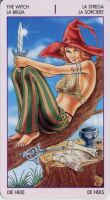 The Witchy Tarot: This is a really nice deck. The Artist has been very free in her interpretation of the Tarot. The kings have been replaced by the Trials, and a fair number of the minors are not what you would expect of them if your drawing on a Waite Tarot background. The artwork however is superb, and is laden with symbols this is definately a good deck for reading the cards through the images. Vs trying to read by rote memorization of the meanings of the cards. In fact given that the LWB, is really just a single folded up sheet of crib notes, reading by rote is virtually impossible.
The Witchy Tarot: This is a really nice deck. The Artist has been very free in her interpretation of the Tarot. The kings have been replaced by the Trials, and a fair number of the minors are not what you would expect of them if your drawing on a Waite Tarot background. The artwork however is superb, and is laden with symbols this is definately a good deck for reading the cards through the images. Vs trying to read by rote memorization of the meanings of the cards. In fact given that the LWB, is really just a single folded up sheet of crib notes, reading by rote is virtually impossible.
Two things about this deck strike me very positively. One the Artwork, is both beautifal and empowering. It portrays the young witches generally as described in the blurb on the box. Beautifal, Elegant and Rebellious. A few cards display the witches in very uncomforable moments, but a Tarot would not be a Tarot if it ignored the shadow side of life. The Trials certaily show the young witches in those uncomfortable moments. They do however open up a new window on the Kings. Numerlogically the kings are 14 1+4/5's and fives generally represent trials in the Tarot. Poverty, Conflict, Defeat, Regret. The artist has embraced this aspect of the 14th card and shown us the Shadow side of the Kings. Sexual Conquest, Humilation, Fierce Opposition, and Being made a Fool. By throwing the shadow of the kings in sharp relief I believe the Artist makes our readings stronger when we return to more conventional decks. As an exercise/ study in comparative tarot, this deck gives you alot to think about.
This is clearly a deck for young women, and it is focused on their concerns. It really has won me over though. I quite like it, and recommend it for relationship readings. For readings on other questions, no. For readings for a more mature woman, the Gendron. But it definately has earned its place on my shelf. BB.
 We have the pleasure of considering the High Priestess, from the Art Nouveau by Lo Scarabeo. This card is appropriate to my mind because in many ways it illustrates the strengths and weakness of this particular deck. The drawing is executed at a very high level of skill, and most of the images are very beautiful. Also in keeping with the Art Nouveau theme, feminine beauty is a central focus. Unfortunately the artistic style clearly trumps the traditions of the Tarot in this deck, and much of the symbolism one would expect in a Waite Child Tarot is lost. Unlike the Witchy Tarot above however, its much harder to read from the art IMHO. I do know one reader who does quite like the deck however, and says he draws on the facial expression of the models in his readings with this deck.
We have the pleasure of considering the High Priestess, from the Art Nouveau by Lo Scarabeo. This card is appropriate to my mind because in many ways it illustrates the strengths and weakness of this particular deck. The drawing is executed at a very high level of skill, and most of the images are very beautiful. Also in keeping with the Art Nouveau theme, feminine beauty is a central focus. Unfortunately the artistic style clearly trumps the traditions of the Tarot in this deck, and much of the symbolism one would expect in a Waite Child Tarot is lost. Unlike the Witchy Tarot above however, its much harder to read from the art IMHO. I do know one reader who does quite like the deck however, and says he draws on the facial expression of the models in his readings with this deck.
As an case in point compare the High Priestess in each deck. In the Universal Waite, the scroll is positioned so one must question if it is the Tora or a Tarot, her robe falls in such away that the final t would be covered. In this image its the Tora no question. While in the Waite the veil on the priestess speaks to her chastity, and distance from the material concerns of life. The Lovely Priestess depicted in the AN, does not seem nearly so unobtainable. Ok that's a small, and perhaps sexist point. My next is not I think, B and J on the column of the Waite, along with the Pomegranates in the background behind, all have symbolic significance that tie the High Priestess to the ancient temple of David in Jerusalem. This aspect is just totally lost from this card. Moving on to the Strength card we see, What I think is, Hercules, just bludgeoning a Satyr. The whole theme of Feminine energies, taming the Masculine, which is usually seen in the VIII of Trumps, is just dropped like a hot rock.
Honestly, I don't think the Artist commissioned had the faintest clue about traditional Tarot symbolism, so I cant recommend it as a deck to read from. I do think however, that some of the minors offer some new insight into the cards. If only because the artist was not drawing on the preconceptions a student of the Tarot would bring to the table. Left to his/her own devises the artist was free to contemplate the themes of the Tarot from a fresh point of view, and has produced to my mind images worthy of some consideration. To the student of comparative Tarot I feel the deck does have something to offer, besides just being very pretty to page through.
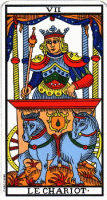 The Camoin House is the last surviving house that produced the Ancient Tarot of Marseille. The heir to that tradition Phillip Camoin and his associate Alexandre Jodorowsky labored for two years to bring us this restoration of the Marseille to its original form and symbolism. Two years may not sound like a long time, but the men involved where uniquely qualified. Phillip had access to the oldest existing plates of the original Tarot. While Alexandre has been a student of the Tarot for 40 years. Together they brought their considerable expertise to bear on the subject. Using computer overlays to compare examples of the Trumps across the years. Searching back through the evolution of the Tarot of Marseille from its original form, to its modern variations. The result is probably as close to a genuinely medieval Tarot as any of us is ever going to see. Why is this important, because as I describe in the short piece in the books section on The Path The Trumps are rich in symbolism, not only as individual cards but more importantly for the greater symbol they create as a whole. Also, it is often said, by skeptics, the Tarot was not used for Divination prior to the 19th century. This may be true. The symbolism of the This Tarot however leaves no doubt That the Tarot of Marseille was the product of a deep and established, school of esoteric knowledge. Implying there must have been a now lost parent, maybe not in the form a Tarot, but a lost predecessor none the less. Despite the myth of Athena, knowledge this rich does not leap full grown from Zeus's noggin.
The Camoin House is the last surviving house that produced the Ancient Tarot of Marseille. The heir to that tradition Phillip Camoin and his associate Alexandre Jodorowsky labored for two years to bring us this restoration of the Marseille to its original form and symbolism. Two years may not sound like a long time, but the men involved where uniquely qualified. Phillip had access to the oldest existing plates of the original Tarot. While Alexandre has been a student of the Tarot for 40 years. Together they brought their considerable expertise to bear on the subject. Using computer overlays to compare examples of the Trumps across the years. Searching back through the evolution of the Tarot of Marseille from its original form, to its modern variations. The result is probably as close to a genuinely medieval Tarot as any of us is ever going to see. Why is this important, because as I describe in the short piece in the books section on The Path The Trumps are rich in symbolism, not only as individual cards but more importantly for the greater symbol they create as a whole. Also, it is often said, by skeptics, the Tarot was not used for Divination prior to the 19th century. This may be true. The symbolism of the This Tarot however leaves no doubt That the Tarot of Marseille was the product of a deep and established, school of esoteric knowledge. Implying there must have been a now lost parent, maybe not in the form a Tarot, but a lost predecessor none the less. Despite the myth of Athena, knowledge this rich does not leap full grown from Zeus's noggin.
A couple of years ago I could not have approached this deck. The Ancient decks just are not a good match to how I, personally, learn things. I now feel I possess sufficient background information to actually learn something from this deck, and I am looking forward to the exploration. It is however a pips deck, so the minors must be memorized, they offer no real clues to the reader visually. If you are a left brain person, and absorb text and numerology easily, you may well find this a wonderful deck. If you are a right brain person, and are more visual in your approach, I think you will love the trumps, but should master the minors first with a more pictorial deck.
Thankyou for your time, BB.